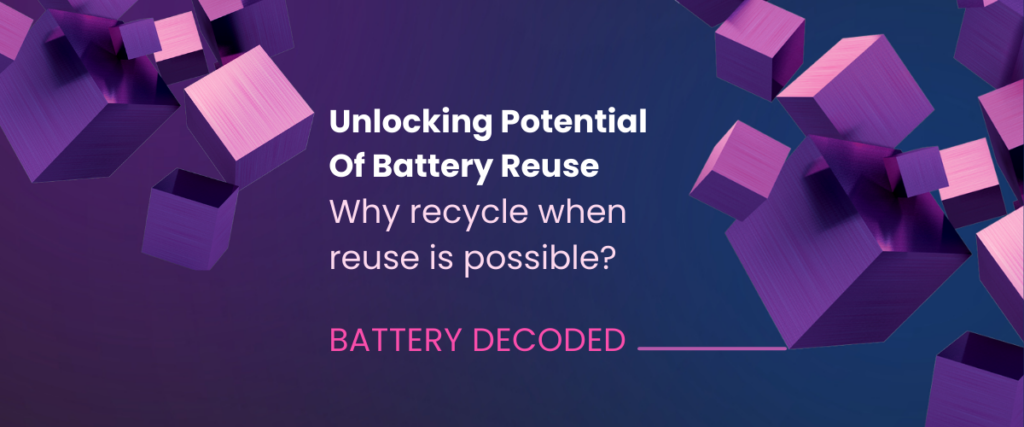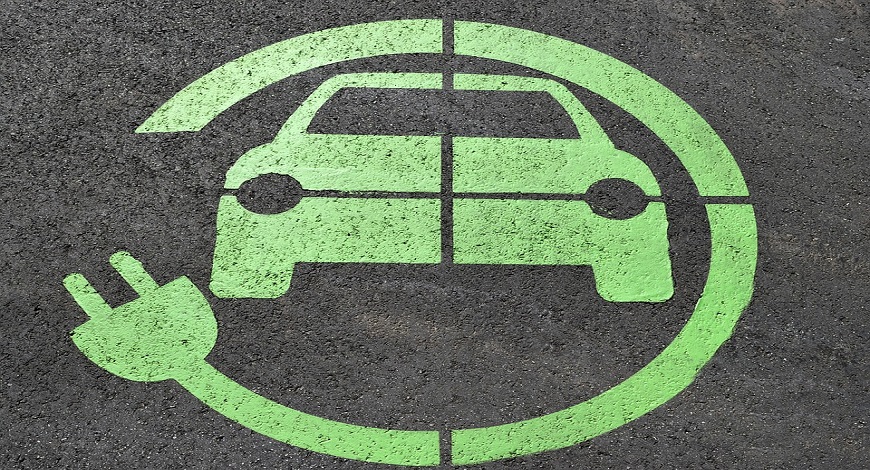
Battery recycling emerged as a solution to address both the resource scarcity and the potential hazards associated with improper battery disposal. The discovery of battery reuse, on the other hand, came as a realization that even after a battery’s primary use had diminished, it still retained a portion of its capacity and functional capability, termed ‘Remaining Useful Life’, based on various factors such as state of health, cycles remaining, and a lot more. This discovery paved the way for exploring second-life applications for batteries.
Over time, the environmental and economic benefits of reusing batteries became clear. By extending the useful life of batteries through repurposing, industries, and individuals could reduce the demand for new battery production, ultimately lessening the strain on raw materials and minimizing waste generation.
In the quest for a sustainable future, battery reuse has emerged as a promising solution in the field of energy transition. The concept of giving batteries a second life is not only innovative but also crucial in our efforts to reduce waste and maximize resources. But why is second-life battery reuse considered a viable first step to battery recycling? The answer lies in its potential to extend the lifespan of batteries and extract additional value from them before they are ultimately recycled. By repurposing batteries for other applications, we can make the most out of their energy storage capabilities and contribute to a more circular economy.
Discover Battery Reuse Innovations
Battery recycling typically involves breaking down batteries into their core components and extracting energy transition materials such as lithium, cobalt, and nickel, which is a destructive process after which any remaining useful life, value, or utility of the cell is lost forever. Battery repurposing often involves refurbished or reconditioned cell modules to be given a second life in less demanding applications that don’t require maximum performance, making them ideal for various stationary energy storage applications.
Recycling may be a destructive process, but by embracing battery reuse as an intermediate step, we can optimize resource utilization while minimizing environmental impact. It allows us to maximize the value derived from each battery before it reaches its end-of-life stage.
Continuing our journey towards sustainability, we need to be aware of the importance and scope of battery reuse in our efforts to build a greener future. By embracing innovative approaches like second-life batteries, we can contribute towards more efficient and responsible use of energy transition materials derived from recycled and repurposed lithium-ion batteries. This is an essential step towards a closed-loop ecosystem and a world where every resource is valued and utilized optimally, prospering with a sustainable and continuous supply of clean energy transition materials.
In the realm of energy transition, the lithium ion battery stands as the workhorse of modern progress. The evolution of batteries, from humble beginnings to indispensable powerhouses, has driven our dependence on their potential. A pivotal era in this journey unfolds as we advance battery recycling and make groundbreaking progress in optimizing battery reuse via real-time remaining useful life and residual value estimation to create high-impact second life battery energy storage solutions. These milestones, resonating with resource scarcity and environmental consciousness, illuminate our path toward a sustainable future.
Battery reuse echoes the principles of a circular economy—a beacon of sustainable resource management. By prolonging battery lifecycles through repurposing, we carve a path toward waste reduction and resource optimization. The historical timeline becomes a testament to our collective commitment to forge an energy transition ecosystem that balances innovation, economic value, and environmental integrity.
Within the realm of economics, battery recycling yields minimal value. Conversely, battery reuse uncovers the untapped potential within existing resources. Battery reuse is key to resource optimization before contemplating recycling. These implications underscore the role of battery reuse in the larger energy transition narrative. As an environmentalist, reuse is always the first choice.
For a comprehensive look at the economic advantages of battery recycling, visit [Economic Benefits of Battery Recycling].
LOHUM is one of the very few companies to viably upscale and proliferate the market in both battery recycling and second-life applications. This helps us process all kinds of end-of-life lithium-ion batteries, and we can add value to the entire battery value chain.
LOHUM has developed proprietary battery testing and diagnostics technology to assess the remaining useful life (RUL) of batteries, via a combination of physics, empirical and data-based models, with industry-pioneering levels of accuracy never seen before.
The use cases of our second-life Battery Energy Storage Systems (BESS) include solutions for solar-powered EV charging stations, homes, commercial facilities, emergency power backup, agriculture, renewable farms, and grid stabilization batteries, the potential is near limitless.
Our in-house BMS technology that can run second-life batteries at high voltages unlocks an entirely new dimension of highly capable and reliable second-life applications that can serve a variety of needs.
In our quest for the clean energy transition, we realize that each innovation bridges us closer to a greener more sustainable future. As the energy transition narrative unfolds the synergy of battery recycling and reuse serves as a clear goal guiding us through the evolving landscape of sustainability.
Battery recycling has come a long way since its inception. In the past, batteries were often discarded in landfills, where they posed a significant environmental hazard. However, with the advent of new recycling technologies and increased awareness of the importance of responsible battery waste management, battery recycling has become an integral part of the energy transition landscape.
Battery reuse, on the other hand, is a rediscovered concept that has gained traction and widespread support in recent years. By repurposing batteries for secondary applications, we can extend their life and maximize their value them before they are ultimately recycled. This not only reduces waste but also helps to conserve valuable resources such as lithium, cobalt, and nickel for nations looking to shore up energy security.
Battery recycling and reuse are two important strategies that can help us to build a more sustainable future. Second-life battery innovations drastically boost the potential of used battery assets and allow for immense value generation over extended periods of time from pre-existing resources.
By embracing these approaches, we can reduce waste, conserve resources, and minimize our environmental impact. As we continue on our journey towards sustainability, let us strive to make the most out of every resource and build a world that is both prosperous and sustainable.
Keep up with LOHUM’s series on simplifying batteries and battery recycling, #BatteryDecoded, on our LinkedIn page for more insightful content on sustainability, battery energy, energy transition, circular economy, battery recycling, and battery repurposing!
Related blogs
This entrepreneur wants India to make its own lithium-ion cells for electric vehicle batteries

Forbes India
Rajat Verma already recovers raw materials from used cells at his venture, LOHUM Cleantech. He wants to close the loop by making cells in India as well.
India needs integrated recycling and repurposing battery business model: Rajat Verma of LOHUM Cleantech

YOURSTORY
In an interaction with AutoStory, Rajat Verma, Founder and CEO of LOHUM Cleantech, speaks about building his company, and about battery manufacturing and repurposing as an industry.
Sourcing Raw Materials Is A Big Challenge In Li-ion Battery Space: Founder Lohum

Business World Disrupt
Recognized as ‘The Most Innovative Company of the year 2022’ by The Confederation of Indian Industry (CII), LOHUM is a producer of sustainable Li-ion battery raw materials
1800 572 8822
Email : enquiry@lohum.com
G98, Site, 5, Kasna, Block A, Surajpur Site V, Greater Noida, Uttar Pradesh 201306
LOHUM Cleantech Private Limited, Plot No. D-7 & 8, Site 5th, Kasna Industrial Area, Greater Noida, Gautam Budh Nagar, Uttar Pradesh – 201308
LOHUM Cleantech Private Limited, Plot No. O-17, Site 5th, Kasna Industrial Area, Greater Noida, Gautam Budh Nagar, Uttar Pradesh – 201308